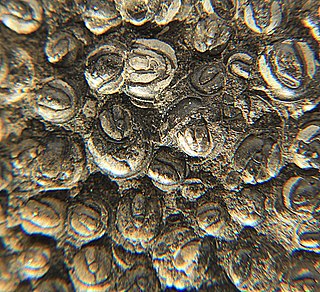 W
WAgnostus, is a genus of agnostid trilobite belonging to the Family Agnostidae, that lived during the late Middle Cambrian – early Upper Cambrian. It is the type genus of the family Agnostidae and is subdivided into two subgenera, Agnostus and Homagnostus.
 W
WAigialosuchus is a genus of long-snouted crocodylomorph that lived in what is now Sweden during the Campanian stage of the Late Cretaceous period and possibly in what is now Denmark during the Paleocene stage of the Paleogene period. The name Aigialosuchus comes from the Greek αἰγιαλός (aigialos), meaning "seashore", and σοῦχος (souchus), meaning "crocodile". The genus contains a single species, A. villandensis, described in 1959 by Per Ove Persson based on material recovered from the Kristianstad Basin in southern Sweden.
 W
WAsaphus is a genus of trilobites that is known from the Lower and Middle Ordovician of northwestern Europe.
 W
WAtrypa is a genus of brachiopod with shells round to short egg-shaped, covered with many fine radial ridges, that split further out and growthlines perpendicular to the costae and 2-3 times wider spaced. The pedunculate valve is a little convex, but tends to level out or even become slightly concave toward the anterior margin. The brachial valve is highly convex. There is no interarea in either valve. Atrypa was a cosmopolitan and occurred from the late Lower Silurian (Telychian) to the early Upper Devonian (Frasnian). Other sources expand the range from the Late Ordovician to Carboniferous, approximately from 449 to 336 Ma. A proposed new species, A. harrisi, was found in the trilobite-rich Floresta Formation in Boyacá, Colombia.
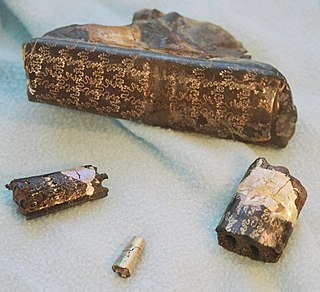 W
WBaculites is an extinct genus of cephalopods with a nearly straight shell, included in the heteromorph ammonites. The genus, which lived worldwide throughout most of the Late Cretaceous, was named by Lamarck in 1799.
 W
WCalymene is a genus of trilobites in the order Phacopida that are found throughout North America, North Africa, and Europe in primarily Silurian outcrops. Calymene is closely related to Flexicalymene, and both genera are frequently found enrolled. Calymene trilobites are small, typically 2 cm in length. The cephalon is the widest part of the animal and the thorax usually has 13 segments.
 W
WConchicolites is a fossil genus of cornulitid tubeworms. Their shells lack vesicular wall structure and have a smooth lumen. They are externally covered with transverse ridges. Some species have spines. They usually occur as encrusters on various shelly fossils. Their fossils are known from the Late Ordovician to the Devonian.
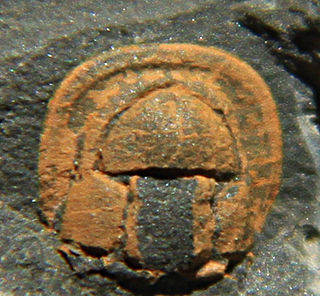 W
WCondylopyge Hawle and Corda (1847) is a genus of agnostid trilobite that lived during the latest Early and early Middle Cambrian, in what are today Canada, Czech Republic, England and Wales, France, Germany, Italy, Morocco, the Russian Federation, Spain, Turkey and Sweden. It can easily be distinguished from all other Agnostida because the frontal glabellar lobe is notably wider than the rear lobe. It belongs to the same family as Pleuroctenium but the frontal glabellar lobe does not fold around the rear lobe, as it does in the latter. The genus is long ranging, possibly spanning the early Cambrian Terreneuvian Series in Nuneaton, central England into at least Drumian strata at various locations elsewhere.
 W
WConocardium is an extinct genus of Rostroconchian mollusk. Its shell-mouth grew to be 2–3 inches (51–76 mm) across. It fed on tiny plants and animals in the water. Fossils have been found all over the world from Ordovician to Permian formations.
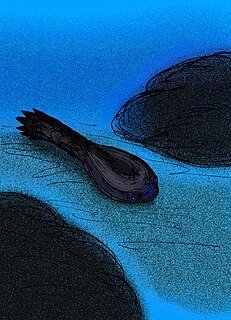 W
WCyathaspis is the type genus of the heterostracan order Cyathaspidiformes. Fossils are found in late Silurian strata in the Cunningham Creek Formation, New Brunswick, Canada and Europe, especially in the Downton Castle Sandstone of Great Britain and Gotland, Sweden. The living animal would have looked superficially like a tadpole, albeit covered in bony plates composed of the tissue aspidine, which is unique to heterostracan armor.
 W
WDuctina is a genus of extinct, small to average sized, eyeless phacopid trilobite, that lived during the Devonian.
 W
WEonatator is an extinct genus of marine lizard belonging to the mosasaur family. It is a close relative of Halisaurus, and part of the same subfamily, the Halisaurinae. It is known from the Late Cretaceous of North America, Colombia and Sweden. Originally, this taxon was included within Halisaurus, but was placed in its own genus, which also led to the subfamily Halisaurinae being created for the two genera.
 W
WFavosites is an extinct genus of tabulate coral characterized by polygonal closely packed corallites. The walls between corallites are pierced by pores known as mural pores which allowed transfer of nutrients between polyps. Favosites, like many corals, thrived in warm sunlit seas, feeding by filtering microscopic plankton with their stinging tentacles and often forming part of reef complexes. The genus had a worldwide distribution from the Late Ordovician to Late Permian.
 W
WFlexicalymene is a genus of trilobites of the order Phacopida, suborder Calymenina. They are found abundantly in North America. Flexicalymene specimens can be mistaken for Calymene, Gravicalymene, Diacalymene and a few other Calymenina genera. They are used as an index fossil in the Ordovician. Ohio and North America are particularly known for being rich with Flexicalymene fossils. Species include F. meeki and F. retrorsa, F. granulosa, F. senaria and F. croneisi (Ontario).
 W
WGeragnostus is a genus of very small agnostid trilobites whose fossils are found Ordovician-aged marine strata from Eurasia, North America and Argentina.
 W
WGlobampyx is an extinct genus raphiophorid trilobites. It lived during the later part of the Arenig stage of the Ordovician Period, approximately 478 to 471 million years ago. Species of the genus are known from Canada, Norway (Svalbard) and Sweden.
 W
WGyrometopus is an extinct genus from a well-known class of fossil marine arthropods, the trilobites. It lived during the Arenig stage of the Ordovician Period, approximately 479 to 472 million years ago.
 W
WHalysites is an extinct genus of tabulate coral. Colonies range from less than one to tens of centimeters in diameter, and they fed upon plankton.
 W
WHarpides is an extinct genus of harpetid trilobite of the family Harpididae.
 W
WHolmipterus is a genus of eurypterid, an extinct group of aquatic arthropods. Fossils of Holmipterus have been discovered in deposits of the Sheinwoodian age in Europe. It only contains one species, which is in turn the type species, H. suecicus, from Gotland, Sweden. The generic name honors Gerhard Holm, a Swedish paleontologist whose work in the arthropods remains as a model to follow.
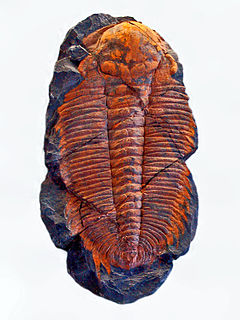 W
WHydrocephalus is an extinct genus of redlichiid trilobite that was very common during the Middle Cambrian of Eurasia and North America, which lasted from 508 to 497 million years ago. This trilobite is up to 20 cm long and more widely built than others of the time. In comparison to other members of its family, its glabella appears swollen.
 W
WLeptaena is an extinct genus of mid-sized brachiopod that existes from the Dariwilian epoch to the Emsian epoch, though some specimens have been found in strata as late in age as the Tournasian epoch. Like some other Strophomenids, Lepteana were epifaunal, meaning they lived on top of the seafloor, not buried within it, and were suspension feeders.
 W
WMonograptus is a genus of graptolites in the Order Graptoloidea. This particular genus is the last stage of the graptoloid evolution before its extinction in the early Devonian. A characteristic of the genus includes one uniserial stipes with very elaborate thecae. This particular genus contains large number of graptolite species and may not be monophyletic.
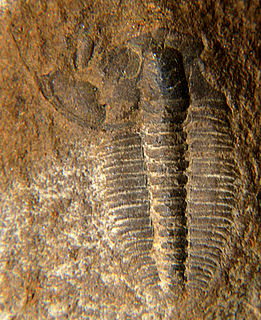 W
WOlenus is a genus of Upper Cambrian ptychopariid trilobite.
 W
WPaleomerus is a genus of strabopid, a group of extinct arthropods. It has been found in deposits from the Cambrian period. It is classified in the family Strabopidae of the monotypic order Strabopida. It contains two species, P. hamiltoni from Sweden and P. makowskii from Poland. The generic name is composed by the Ancient Greek words παλαιός (palaiós), meaning "ancient", and μέρος (méros), meaning "part".
 W
WPhalagnostus is a genus of small trilobites, in the order Agnostida. It lived during the Middle Cambrian, in what are now Canada, China, the Czech Republic, Denmark, England, France, the Russian Federation, Wales, Sweden, and possibly the United States (Vermont). The headshield is almost entirely effaced and wider than the tailshield. The pygidium is also very effaced, but the ovate pygidial axis is well defined and a border furrow is also present.
 W
WPlatystrophia is an extinct genus of brachiopods that lived from the Ordovician to the Silurian in Asia, Europe, North America, and South America. It has a prominent sulcus and fold. It usually lived in marine lime mud and sands.
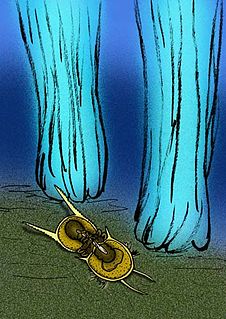 W
WPleuroctenium is an agnostid trilobite belonging to the family Condylopygidae. The genus occurs in Middle Cambrian (Drumian) strata of Canada, the Czech Republic, England and Wales, France, and Sweden.
 W
WPliomera is a genus of trilobites that lived during the Middle Ordovician on the paleocontinent Baltica, now Norway, Sweden, Estonia and the Russian Federation, and in Argentina. It can be recognized for its pentagonal glabella widest between the frontal corners, with an inverted V-shaped occipital ring. In front of the occipital furrow that crosses the entire glabella, two pairs of dead-ending furrows create three side lobes left and right. The front of the glabella also has three dead-ending furrows, a very short one on the midline and left and right a longer one, directed inward and slightly backward. The eyes are small and are not connected to the glabella by an eye ridge. The thorax and pygidium are very regularly divided into up to 23 rather narrow segments, without a furrow within each of the pleurae. The pleurae are clearly wider than the axis. The pygidium ends in downward pointing toothlike spines.
 W
WPlutonides Hicks, 1895, is a genus of Middle Cambrian trilobite belonging to the Paradoxididae. In terms of the Scandinavian Middle Cambrian sequence the genus ranges from the Eccaparadoxides oelandicus Biosuperzone (Acadoparadoxides? pinus Biozone on Trwyncynddeiriog headland located 1.3 km SSW of St David’s Cathedral and 500 m east of Porth Clais Harbour - Pen-y-Cyfrwy Member, Newgale Formation, and possibly to middle part of the Mawddachites hicksii Biozone on the Penpleidiau Headland of Caerfai Bay south of St David’s in SW Wales, Locs. TC-1 & CF-1 of Rees et al.,.
 W
WScanisaurus is a dubious genus of plesiosaur that lived in what is now Sweden and Russia during the Campanian stage of the Late Cretaceous period. The name Scanisaurus means "Skåne lizard", Skåne being the southernmost province of Sweden, where a majority of the fossils referred to the genus have been recovered. The genus contains one species, S. nazarowi, described in 1911 by Nikolay Bogolyubov as a species of Cimoliasaurus based on a single vertebral centrum discovered near Orenburg, Russia.
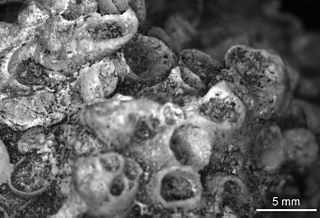 W
WSeptalites is a genus of cornulitid tubeworms. Their shells lack vesicular wall structure and have a smooth lumen filled with numerous transverse septa. They are externally covered with transverse ridges. Their fossils are known only from the Silurian of Gotland.
 W
WSerratolamna is an extinct genus of mackerel sharks belonging to the family Cretoxyrhinidae.
 W
WSphaeragnostus is an extinct genus from a well-known class of fossil marine arthropods, the trilobites. It can be recognized by having two thorax segments, a totally effaced headshield, while the tailshield although effaced, has a clear furrow parallel to its border, and a short, convex, subcircular axis. It lived during the Ordovician.
 W
WToragnostus is a genus of trilobites restricted to the late Middle Cambrian. Its remains have been found in the United States, Greenland, Denmark, China, Sweden, the Russian Federation, and Kazakhstan. Its headshield and tailshield are almost completely effaced and it has two thorax segments.
 W
WTrinodus is a very small to small blind trilobite, a well known group of extinct marine arthropods, which lived during the Ordovician, in what are now the Yukon Territories, Virginia, Italy, Czech Republic, Poland, Denmark, Sweden, Svalbard, Ireland, Scotland, Wales, Iran, Kazakhstan and China. It is one of the last of the Agnostida order to survive.